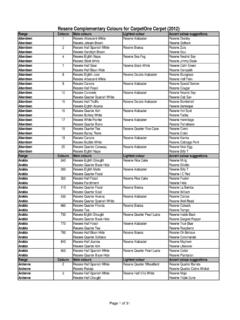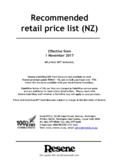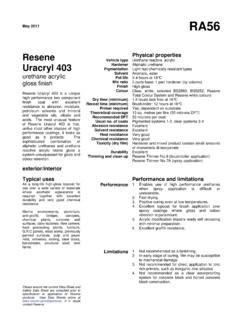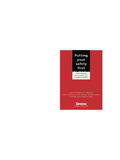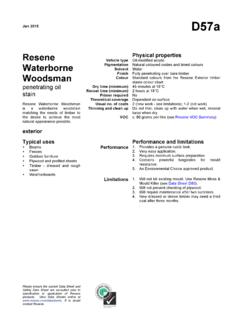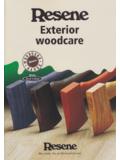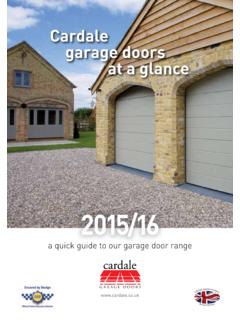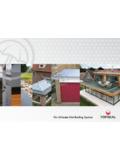Transcription of THE STORY OF NEW ZEALAND’S OWN PAINT COMPANY
1 THE STORY OF NEW zealand S OWN PAINT COMPANYAn illustration from an early advertisement for Resene waterborne was started in 1946 by an Eastbourne builder, Ted Nightingale, who needed an alkali resistant PAINT to cover his concrete buildings. There was nothing available at the time, so in typical kiwi style he developed his own - in a cement mixer in his garage! In response to demand from other builders, Ted commenced producing his PAINT on a commercial basis under the brand name was a cement based PAINT required by builders because there were really no paints on the market at that stage that were suitable for use over concrete. Waterborne paints were not available until years later. As well as Stipplecote, Ted manufactured a range of admixtures, such as No Bond and Curecrete, which are still around today. The initial garage production facility was superceded by the establishment of Resene s first factory in an old stable in Tinakori Road, Wellington later that 1951, Ted Nightingale launched the first waterborne PAINT in New zealand under the brand name Resene - a name derived from the main ingredient of PAINT - resin.
2 This launch was followed in 1952 by COMPANY registration under the name Stipplecote Products Ltd and a move to a new larger factory in Kaiwharawhara, Wellington. A period of innovation was to paints had a very slow start. The marketplace was cautious with the new technology and had difficulty understanding that a waterborne PAINT would not wash off the walls with water. Customers initially remained loyal to lead and solventborne paints. It was only after a massive sales effort that waterborne PAINT sales really took off. Demonstrations were run in shop windows showing boards being painted with waterborne paints and then the brushes being rinsed off in water. People standing in the street could not believe that the PAINT wouldn t just wash off the market eventually responded to the new PAINT technology and Resene s perseverance paid off with a period of rapid expansion during the late 1950s and early 1960s.
3 As the emphasis shifted away from cement based paints towards waterborne paints, the COMPANY name was changed to Resene Paints Ltd in 1977. Although the COMPANY had added a line of solventborne paints to the range in the late 1950s and early 1960s, waterborne paints remained its primary this time, the directors realised Resene had gone as far as it could with its limited manufacturing unit and selling laid the foundation for several key decisions that inhindsight proved pivotal. The first decision was to upgrade the manufacturing facilities to provide increased factory space. Resene shifted premises from its older site in Kaiwharawhara to Gough Street in Seaview, Lower Hutt, where it remained for 25 years before shifting to its current location in Naenae, Lower Hutt in 1992.
4 By relocating to the Seaview site, Resene became situated in an industrial area, which later provided for further expansion with a second manufacturing unit a few blocks second and probably most crucial decision in Resene COMPANY history was to completely overhaul the COMPANY s marketing. In a huge gamble, Resene decided to risk alienating the industry s traditional sales outlets by sidestepping them in favour of using its own staff to sell directly to the 1970, Resene employed a sales manager and set about opening branches throughout New zealand . Initially each branch consisted of a warehouse as a base and a sales representative who drove around making calls on tradespeople. At about the same time the practice of leasing motor vehicles came into being and this allowed Resene to set up a fleet of vehicles without a huge capital initially focused on the professional market in Wellington and then rolled this strategy out to focus on towns like those in the Hawkes Bay - areas where the big companies were less focused.
5 Only once Resene had established itself in most smaller areas, did Resene increase its focus on between calls to tradespeople, the Resene sales representatives called on the architectural profession, Government Departments and local bodies. As a result of favourable dealings, many began to specify Resene paints on 1972, Tony Nightingale, Ted s son, took over the operation of the : An early advertisement for Resene Stipplecote, screen-printed on : A series of early advertisements showing the benefits of innovative Resene waterborne NZ OWNED1975 saw the launch of the first of a national chain of retail stores. The move into retail occurred almost by accident. Tony bought a wallpaper COMPANY that happened to own a store in Marion Street, Wellington. It was at this site that the first store, originally called the Marion Street PAINT shop, was established.
6 Following overwhelming success with the opening of this store, the ColorShop concept was conceived and duplicated in other regions. Soon there were ColorShops in Auckland, Hawkes Bay, Dunedin, Hamilton and this foray into retail, the mainstay of Resene s business has continued to be specifiers and professional painters who demand a high quality PAINT that is easy to apply, a wide range of colours and a high level of service and problem solving ability from the PAINT also built itself a reputation as the colour leader,with a number of firsts in this area: In 1969 Resene set up a new system of colour, the British Standard Specification colour range (BS2660 range), which provided a range of strong colours at a time when New Zealanders were used to pastel colours. The stronger BS4800 range followed in 1973. The launch of the BS5252 colour range in 1976 was a world first.
7 Resene pioneered the development of coloured PAINT bases, where previously only white was used. Resene was also the first COMPANY to offer a full range of testpots in New zealand in 1981. In 1985, the Total Colour Multi-Finish System was launched. Combining an extensive range of colours with interlinked tinting systems for both interior and exterior, the flexibility and adaptability of this colour system was welcomed with open arms by specifiers and retail customers alike. Resene delivered virtual painting technology into thousands of homes with the launch of Resene EzyPaint in 1999, available on CD or as a free download from the Resene website. Virtual painting later expanded to virtual reality with Resene ColourVision enabling a whole home to be virtually painted using a smartphone and VR headset. In 1999, the first of the Resene fashion fandecks, The Range 2000, was released showcasing fashion colours for the coming this time, Resene has also been known as a leader in the development of environmentally friendlier products from the basic innovation of Resene waterborne paints to the removal of lead from decorative paints in the late 1960s well ahead of other reinforce this position, Resene joined the Environmental Choice programme in 1996, making it easier for consumers to select paints that ease the burden on the relatively recent innovation of waterborne enamels has enabled customers to substitute waterborne products for solventborne products.
8 In 2004 Resene introduced the Resene PaintWise PAINT and PAINT packaging recovery programme, the first comprehensive PAINT and PAINT packaging product stewardship programme in this part of the world. Over 3 million PAINT containers have been recycled and over 250,000 litres of recycled PAINT has been donated to communities to cover , Resene s Head Office is situated in Naenae, Lower Hutt. Resene waterborne products are produced at this site. Solventborne products are produced at a separate manufacturing facility in Upper Hutt, produces both decorative and protective coatings for residential, commercial and industrial needs. Protective coatings technology was first purchased in 1977 from Giant Products. In 1999 Resene developed and released its own range of engineered coating systems, an extensive range that remains popular also has a presence in both Fiji, servicing the South Pacific market, and Australia.
9 Resene Paints (Pacific) Ltd was established in 1965. Resene Paints (Australia) Ltd was later established in 1990 supplying quality Resene PAINT to the Australian market. Closer to home, the Resene Group also includes Altex Coatings Ltd, a Tauranga based manufacturer of marine, industrial and protective coatings, Resene Automotive and Light Industrial, focused on high end specialist and automotive products and Resene Construction Systems, providing cladding systems. Not a COMPANY to stop there, Resene also exports PAINT and colour technology to offshore s son Nick Nightingale was appointed General Manager in 1999, before becoming Managing Director just a few years many decades of experience under its belt, and three generations of the Nightingale family keeping the momentum going, Resene has certainly shown that kiwi ingenuity can win through delivering innovative and high quality durable products, colours and on our history, the future is guaranteed to be just as colourful an adventure!
10 Below: Continued series of : An early Resene colour on environmentally responsible paper, which complies with the requirements of environmental management systems EMAS and ISO14001, using vegetable-based inks. Please 738 RESENE (737 363) STORY OFNEW zealand S OWNPAINT COMPANY100% NZ OWNED
